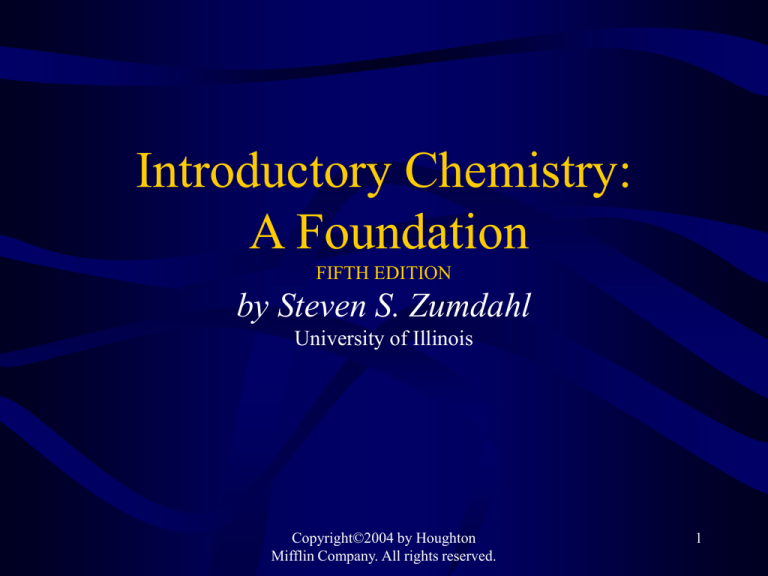
Introductory Chemistry:
A Foundation
FIFTH EDITION
by Steven S. Zumdahl
University of Illinois
Copyright©2004 by Houghton
Mifflin Company. All rights reserved.
1
Elements, Atoms & Ions
Chapter 4
Copyright©2004 by Houghton
Mifflin Company. All rights reserved.
2
Elements
• Over 112 known, of which 88 are found in nature
– others are man-made
• Abundance is the percentage found in nature
– oxygen most abundant element (by mass) on earth and in
the human body
– the abundance and form of an element varies in different
parts of the environment
• Each element has a unique symbol
• The symbol of an element may be one letter or two
– if two letters, the second is lower case
Copyright©2004 by Houghton
Mifflin Company. All rights reserved.
3
Copyright©2004 by Houghton
Mifflin Company. All rights reserved.
4
Copyright©2004 by Houghton
Mifflin Company. All rights reserved.
5
John Dalton
(1766 –1844)
was an
English
scientist who
made his
living as a
teacher in
Manchester.
Copyright©2004 by Houghton
Mifflin Company. All rights reserved.
6
Dalton’s Atomic Theory
Elements are composed of atoms
– tiny, hard, unbreakable, spheres
All atoms of a given element are identical
– all carbon atoms have the same chemical and physical
properties
Atoms of a given element are different from those of
any other element
– carbon atoms have different chemical and physical properties
than sulfur atoms
Copyright©2004 by Houghton
Mifflin Company. All rights reserved.
7
Dalton’s Atomic Theory
Atoms of one element combine with atoms of
other elements to form compounds.
– Law of Constant Composition
• all samples of a compound contain the same proportions
(by mass) of the elements
– Chemical Formulas
Copyright©2004 by Houghton
Mifflin Company. All rights reserved.
8
Multiple Proportions
Copyright©2004 by Houghton
Mifflin Company. All rights reserved.
9
Dalton’s Atomic Theory
Atoms are indivisible in a chemical process.
– all atoms present at beginning are present at the end
– atoms are not created or destroyed, just rearranged
– atoms of one element cannot change into atoms of
another element
• cannot turn Lead into Gold by a chemical reaction
Copyright©2004 by Houghton
Mifflin Company. All rights reserved.
10
Formulas of Compounds
• Compound - a distinct substance that is
composed of atoms of two or more elements
• Each element represented by its letter symbol
• The number of atoms of each element is
written to the right of the element as a
subscript (if there is only one atom, the 1
subscript is not written)
NaCl
CO
• Polyatomic groups are placed in parentheses
– if more than one
Copyright©2004 by Houghton
Mifflin Company. All rights reserved.
11
The Structure of the Atom
• J.J. Thomson investigated a beam called a
cathode ray
• he determined that the ray was made of tiny
negatively charged particles we call electrons
• Thomson also found that atoms of different
elements all produced these same electrons
Copyright©2004 by Houghton
Mifflin Company. All rights reserved.
12
Schematic of a cathode ray tube
Copyright©2004 by Houghton
Mifflin Company. All rights reserved.
13
The Electron
• Tiny, negatively charged particle
• Very light compared to mass of atom
– 1/1836th the mass of a H atom
Copyright©2004 by Houghton
Mifflin Company. All rights reserved.
14
“Plum Pudding” Model
Copyright©2004 by Houghton
Mifflin Company. All rights reserved.
15
Thomson’s Plum Pudding Model
Atom breakable!!
Atom has structure
Electrons suspended in a positively charged electric field
– must have positive charge to balance negative charge
of electrons and make the atom neutral
mass of atom due to electrons
atom mostly “empty” space
– compared size of electron to size of atom
Copyright©2004 by Houghton
Mifflin Company. All rights reserved.
16
Ernest
Rutherford
(1871-1937)
Copyright©2004 by Houghton
Mifflin Company. All rights reserved.
17
Rutherford’s Gold Foil Experiment
• How can you prove something is empty?
• Put something through it
– use large target atoms
– use very small particle as bullet with very high energy
• bullet = alpha particles, target atoms = gold foil
– particles have a mass of 4 amu & charge of +2 c.u.
– gold has a mass of 197 amu
Copyright©2004 by Houghton
Mifflin Company. All rights reserved.
18
Rutherford’s experiment on
-particle bombardment of metal foil.
Copyright©2004 by Houghton
Mifflin Company. All rights reserved.
19
Rutherford’s Results
• Over 98% of the particles went straight through
• About 2% of the particles went through but
were deflected by large angles
• About 0.01% of the particles bounced off the
gold foil
Copyright©2004 by Houghton
Mifflin Company. All rights reserved.
20
Rutherford’s Nuclear Model
The atom contains a tiny dense center called the
nucleus
– the volume is about 1/10 trillionth the volume
of the atom
The nucleus is essentially the entire mass of the
atom
The nucleus is positively charged
– the amount of positive charge of the nucleus
balances the negative charge of the electrons
The electrons move around in the empty space of
the atom surrounding the nucleus
Copyright©2004 by Houghton
Mifflin Company. All rights reserved.
21
A Nuclear
Atom
Copyright©2004 by Houghton
Mifflin Company. All rights reserved.
22
Structure of the Nucleus
• The nucleus was found to be composed of two kinds of
particles:
Protons
– charge = +1
– mass is about the same as a hydrogen atom
• Since protons and electrons have the same amount of
charge, for the atom to be neutral there must be equal
numbers of protons and electrons
Neutrons
– has no charge
– has a mass slightly more than a proton
Copyright©2004 by Houghton
Mifflin Company. All rights reserved.
23
Copyright©2004 by Houghton
Mifflin Company. All rights reserved.
24
The Modern Atom
• We know atoms are composed of three main
pieces - protons, neutrons and electrons
• The nucleus contains protons and neutrons
• The nucleus is only about 10-13 cm in diameter
• The electrons move outside the nucleus with an
average distance of about 10-8 cm
– therefore the radius of the atom is about 105 times
larger than the radius of the nucleus
Copyright©2004 by Houghton
Mifflin Company. All rights reserved.
25
Isotopes
• All atoms of an element have the same number of protons
• The number of protons in an atom of a given element is
the same as the atomic number (found on the periodic
table)
• Atoms of an element with different numbers of neutrons
are called isotopes
• All isotopes of an element are chemically identical
– undergo the exact same chemical reactions
• Isotopes of an element have different masses
• Isotopes are identified by their mass numbers
– mass number = protons + neutrons
Copyright©2004 by Houghton
Mifflin Company. All rights reserved.
26
Calculating Mass Number (A)
mass number = protons + neutrons
or
A=Z+n
A C
Z
Copyright©2004 by Houghton
Mifflin Company. All rights reserved.
27
Elements
• Arranged in a pattern called the Periodic Table
• Position on the table allows us to predict properties of
the element
• Metals
– about 75% of all the elements
– lustrous, malleable, ductile, conduct heat and
electricity
• Nonmetals
– dull, brittle, insulators
• Metalloids
– also know as semi-metals
– some properties of both metals & nonmetals
Copyright©2004 by Houghton
Mifflin Company. All rights reserved.
28
The Modern Periodic Table
• Elements with similar chemical and
physical properties are in the same column
• Columns are called Groups
• Rows are called Periods
• Each period shows the pattern of properties
repeated in the next period
Copyright©2004 by Houghton
Mifflin Company. All rights reserved.
29
The Modern Periodic Table
• Main Group = Representative Elements
– “A” columns
• Transition Elements
– all metals
• Bottom rows = Inner Transition Elements =
Rare Earth Elements
– metals
– really belong in Period 6 & 7
Copyright©2004 by Houghton
Mifflin Company. All rights reserved.
30
The
Modern
Periodic
Table
Copyright©2004 by Houghton
Mifflin Company. All rights reserved.
31
Important Groups
• Group 8 = Noble Gases
• He, Ne, Ar, Kr, Xe, Rn
• all colorless gases at room
temperature
• very non-reactive, practically
inert
• found in nature as a
collection of separate atoms
uncombined with other
atoms
• Noble Metals
• Ag, Au, Pt
• all solids at room
temperature
• least reactive metals
• found in nature
uncombined with
other atoms
Copyright©2004 by Houghton
Mifflin Company. All rights reserved.
32
Important Groups - Halogens
• Group 7A = Halogens
• very reactive
nonmetals
• react with metals to
form ionic compounds
• HX all acids
• Fluorine = F2
– pale yellow gas
• Chlorine = Cl2
– pale green gas
• Bromine = Br2
– brown liquid that has lots of
brown vapor over it
– Only other liquid element at
room conditions is the metal
Hg
• Iodine = I2
– lustrous, purple solid
Copyright©2004 by Houghton
Mifflin Company. All rights reserved.
33
Diatomic Molecules
Copyright©2004 by Houghton
Mifflin Company. All rights reserved.
34
Allotropes
• Allotropes - nonmetallic elements that can
exist in different forms with different
physical properties
• The different physical properties arise from
the different arrangements of the atoms in
the solid
• Allotropes of Carbon include
– diamond
– graphite
– buckminsterfullerene
Copyright©2004 by Houghton
Mifflin Company. All rights reserved.
35
Electrical Nature of Matter
• Most common pure substances are very poor conductors
of electricity
– with the exception of metals and graphite
– Water is a very poor electrical conductor
• Some substances dissolve in water to form a solution that
conducts well - these are called electrolytes
• When dissolved in water, electrolyte compounds break up
into component ions
– ions are atoms or groups of atoms that have an electrical charge
Copyright©2004 by Houghton
Mifflin Company. All rights reserved.
36
Ions
• ions are atoms or groups of atoms that have an electrical
charge
• ions that have a positive charge are called cations
– form when an atom loses electrons
• ions that have a negative charge are called anions
– form when an atom gains electrons
• ions with opposite charges attract
– therefore cations and anions attract each other
• moving ions conduct electricity
• compound must have no total charge, therefore we must
balance the numbers of cations and anions in a compound to
get 0 total charge
Copyright©2004 by Houghton
Mifflin Company. All rights reserved.
37
Cations
• Metals form cations
• For each positive charge the ion has 1 less electron than the
neutral atom
– Na = 11 e-, Na+ = 10 e– Ca = 20 e-, Ca+2 = 18 e-
• Cations are named the same as the metal
sodium
Na Na+ + 1esodium ion
calcium
Ca Ca+2 + 2e- calcium ion
• The charge on a cation can be determined from the Group
number on the Periodic Table for Groups IA, IIA, IIIA
– Group 1A +1, Group 2A +2, (Al, Ga, In) +3
Copyright©2004 by Houghton
Mifflin Company. All rights reserved.
38
Anions
• Nonmetals form anions
• For each negative charge the ion has 1 more electron
than the neutral atom
– F = 9 e-, F- = 10 e– P = 15 e-, P3- = 18 e-
• Anions are named by changing the ending of the name
to -ide
fluorine
F + 1e- F- fluoride ion
oxygen
O + 2e- O2oxide ion
• The charge on an anion can be determined from the
Group number on the Periodic Table
– Group 7A -1, Group 6A -2
Copyright©2004 by Houghton
Mifflin Company. All rights reserved.
39
The ions formed by selected members
of Groups 1, 2, 3, 6, and 7
Copyright©2004 by Houghton
Mifflin Company. All rights reserved.
40
The
arrangement of
sodium ions
(Na+) and
chloride ions
(Cl-) in the ionic
compound
sodium
chloride.
Copyright©2004 by Houghton
Mifflin Company. All rights reserved.
41







